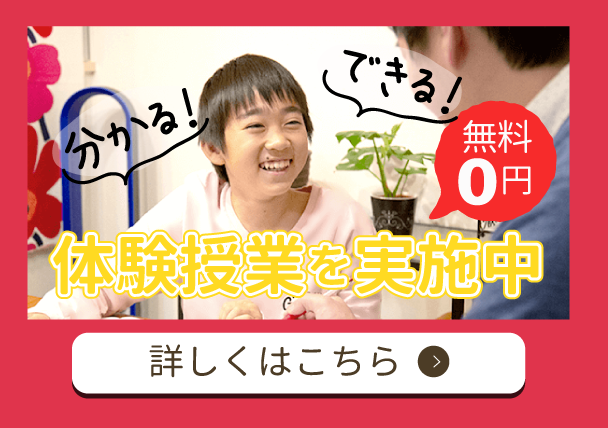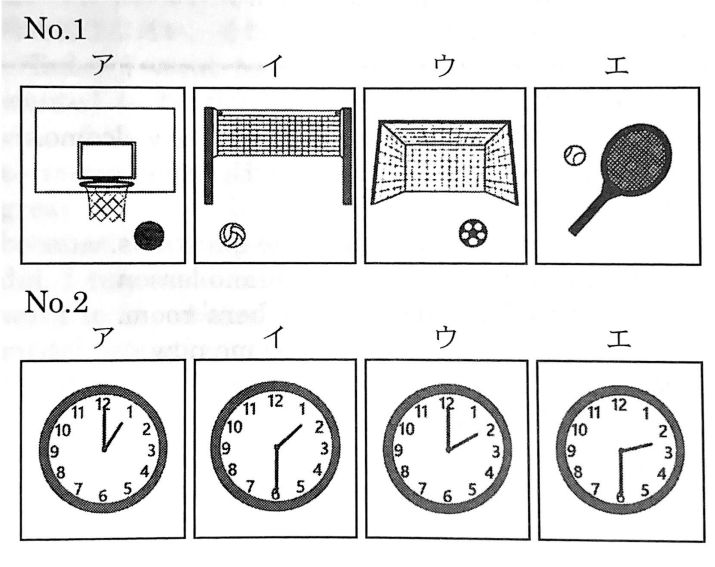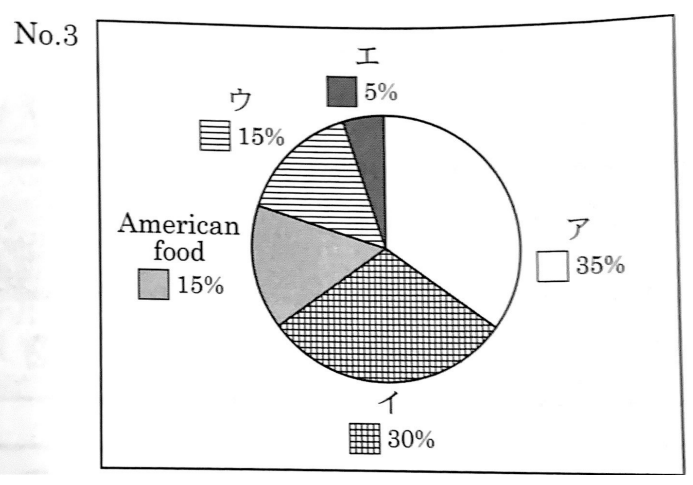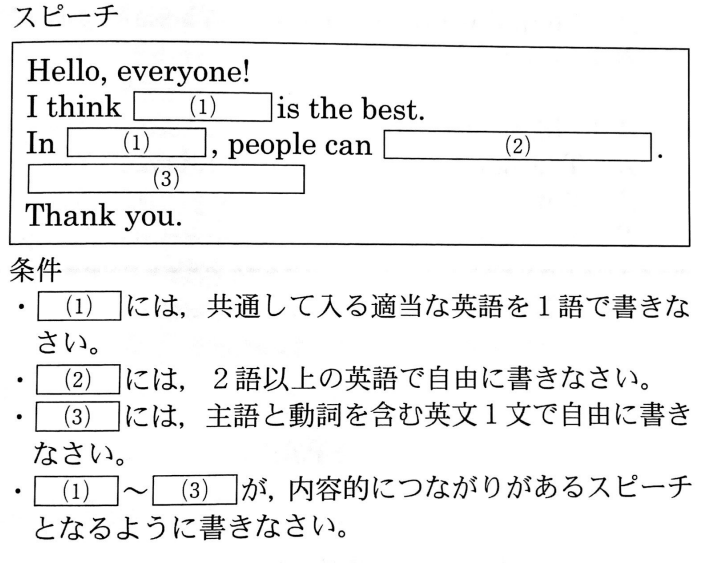

【放送内容】
問1です。3題とも最初に短い対話が読まれます。次に、それぞれの対話の後で,その内容について,クエスチョンと言った後に英語で質問があります。その質問の答えとして最も適当なものを、ア、イ,ウ,エから選びなさい。では、始めます。
No. 1
A : Do you do any club activities, Megumi?
B : Yes. I’m in the volleyball club. What club do you want to join, Tom?
A : Well, I like soccer, so I want to join the soccer club.
Question: What club does Tom want to join?
No.2
A : What time will the concert start, Cathy?
B: It’ll start at two o’clock, Dad. The hall will open at one thirty.
A : Then, let’s leave the house at one o’clock.
Question: What time will the concert hall open?
No.3
A : Look at this figure. I asked my classmates a question, “What foreign food do you like?”
B: Well, Italian food is the most popular.
A : Right. Korean food is also very popular. It’s more popular than my favorite foreign food, Chinese. Chinese food is as popular as American food.
B : I like French food, but it’s only five percent!
Question: Which one shows Chinese food in the figure?


【放送内容】
間2です。4題とも、それぞれ示された場面における、直子とニックの対話です。最初に、直子が、続いてニックが話します。その次に、直子が話すところで、チャイムが鳴ります。このチャイムの鳴るところで、直子が話す言として最も適当なものを、ア、イ,ウ,エから選びなさい。では、始めます。
No.1[昼休みの対話]
Naoko : I haven’t eaten lunch yet.
Nick : Oh, you’re hungry, right?
Naoko:(チャイム音)
No.2[放課後の対話]
Naoko: I’lI see Mr. Suzuki to ask some questions about today’s science class now.
Nick: I also have some questions. Can I go with you?
Naoko:(チャイム音)
No.3[店での対話]
Naoko: I like this yellow T-shirt, but it’s too expensive!
Nick: How about this white one? It’s also good and cheaper.
Naoko :(チャイム音)
No.4[下校時の対話]
Naoko: Hi, Nick. Do you have time tomorrow? I want to play badminton in the gym.
Nick: I’m going to eat lunch with my family tomorrow, so I can play it with you after that. Let’s meet at three.
Naoko:(チャイム音)
No.1[昼休みの対話]
ア:Yes, I am. イ:You’re welcome. ウ:No, it’s not mine. エ:Here you are.
No.2[放課後の対話]
ア:No, you can’t answer the questions.
イ:I’m sorry, but I have a piano lesson.
ウ:Sure, let’s go to the teacher’s room.
エ:Yes, you can come to see me now.
No.3 [店での対話]
ア:I’ll buy the white shoes.
イ:How much is it?
ウ:How many T-shirts do you have?
エ:I’ll ask the price of the yellow one.
No.4 [下校時の対話]
ア:Then, I’ll take my lunch box, too.
イ:So, you can eat lunch with me.
ウ:Yes, I enjoyed badminton.
エ:OK, see you in the gym.
【放送内容】
問3です。次に読まれる英文は、ALTの先生が授業中に話している場面のものです。その内容について、No.1からNo.3の質問の答えとして最も適当なものをアイウエから選びなさい。No.1からNo.3の質間に目を通しなさい。
I enjoy learning Japanese. The expression I often use is “sumimasen.” When I came to Japan last year, I knew it means “I’m sorry.” But, I didit understand why people say “sumimasen” many times. Now I know it also means “Excuse me” and “Thank you.” I think this is a very useful expression. In English, we also have such useful expressions. For example, we say, “I’m fine.” This expression is used in various scenes. If someone asks, “Are you OK?,” we often say, “I’m fine.” We use this when we want to say “Yes.” Also, at a convenience store, we’re asked,
“Do you need a bag?” We can use “I’m fine” if we don’t need a bag. In this way, we can use this expression when we want to say “Yes” and also when we want to say “No.” Learning languages is interesting, right? I want you to learn useful English expressions and try to use them. I hope studying English will be more interesting for you!
No.1 ALTの先生は”I’m fine”という表現について、どのように言っていますか。
ア:Japanese people use “I’m fine” in various ways.
イ:It’s interesting to know why people use “I’m fine” many times.
ウ:To use “I’m fine” is too difficult for Japanese students.
エ:People often say “I’m fine” when they’re asked, “Are you OK?”
No.2 ALTの先生の話からわかることは何ですか。
ア:There are many people who like studying foreign languages.
イ:Some expressions are used in different ways in different scenes.
ウ:The expression, “sumimasen” is very popular all over the world.
エ:Many people want to come to Japan to learn about Japanese culture.
No.3 ALTの先生が、この話の中で最も伝えたいことは何ですか。
ア:Learning useful English expressions will help students enjoy studying English.
イ:Students need to learn how to say “Yes” and “No” in many ways in English.
ウ:It’s important for students to study both Japanese and English for their future.
エ:Speaking in English will be easier for students if they learn more expressions.
【放送内容】
問4です。次に読まれる英文は、英語の先生が生徒に指示をしている場面のものです。あなたが生徒になったつもりで,示された条件にしたがって,スピーチを完成させなさい。スピーチと条件に目を通しなさい。
In the next lesson, you’ll make a short speech.The topic is, “Which season is the best to visit your hometown?” If you’re asked about it by tourists from other countries, how will you answer? In your speech, I want you to tell us which season is the best and why you chose the season. Then, please tell us more information about the reason.
Your speech is not about your favorite season. You should think about the foreign tourists who would like to visit your hometown. Also, your speech should be understood by people who don’t speak Japanese.Well, I can’t wait for our next lesson! Good luck!

No.1
【答え】ウ
【解説】質問の意味は「トムは何のクラブに入りたいですか?」なので、放送内容「I want to join the soccer club.」より、ウが適する。
No.2
【答え】イ
【解説】質問の意味は「コンサートホールは何時に開きますか?」なので、放送内容「The hall will open at one thirty.」より、イが適する。
No.3
【答え】ウ
【解説】質問の意味は「図の中で中国料理を示しているものはどれですか?」なので、放送内容「Chinese food is as popular as American food.」より、ウが適する。
No.1
【答え】ア
【解説】「おなかがすいていませんか?」と聞かれているので、「はい、そうです。」と答えればよい。
No.2
【答え】ウ
【解説】「分からないところがあるから先生に聞きに行く、一緒に行かない?」と言われているので、「いいよ、じゃあ行こうか」と答えればよい。
No.3
【答え】イ
【解説】「黄色のTシャツが気に入ってるが高い」という直子に、ニックが「この白いTシャツなら安いよ」と進めているので、「いくら?」と聞くのが会話として適する。
No.4
【答え】エ
【解説】直子が「明日体育館でバドミントンをしよう」と誘い、ニックは「家族との昼ごはんの後、3時ならいいよ」と答えているので、「OK、体育館でまた会おう。」が会話として適切。
No.1
【答え】エ
【解説】消去法で解いていく。アは「Japanese people use “I’m fine”」が不適。日本人が使うのは”sumimasen”。イは放送文中に記述無し。ウも放送文中に記述無し。
No.2
【答え】イ
【解説】この主題は日本語の”sumimasen”のように役に立つ表現が英語にもあるよという話。
No.3
【答え】ア
【解説】放送文中「I want you to learn useful English expressions and try to use them. I hope studying English will be more interesting for you!」より、アが最適。
解答例
(1)winter
(2)enjoy skiing
(3)My hometown is popular amoung people who love skiing.
解説略